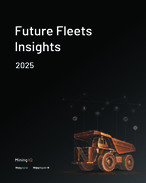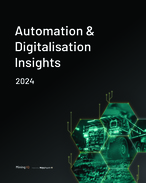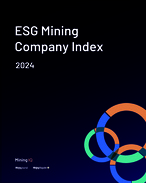This article is 1 year old. Images might not display.
Companies like Solvay, which focuses on advanced materials and specialty chemicals, also face the same challenge as miners - the need to develop solutions that meet huge mineral shortfalls, but simultaneously in a much greener way.
Transition metals such as lithium, copper, cobalt, nickel, and rare earth elements are crucial for the production of batteries and renewable energy technologies. As available ore grades decline, mines are confronted with more impurities, presenting challenges for traditional metal extraction. Within the field of extractive metallurgy, flotation and solvent extraction offer highly effective means of selectively separating and concentrating these metals, allowing for more efficient metal recovery. Highly selective reagent chemicals are critical to extractive metallurgy, improving throughput, efficiency and sustainability.
Mining companies are continually looking to improve their processes, especially in terms of safety, environmental and health-related concerns. For these reasons, companies like Solvay aim to bring to the market innovative products that minimise the use of harmful chemicals and reduce waste generation, in alignment with the principles of a green economy, which promotes more sustainable mineral processes.
Solvent extraction, in particular, is growing in popularity due to its versatility and applications potential. The process facilitates metal recycling and resource conservation, in line with the principles of a circular economy. And as demand for batteries and transition metals continues to grow, the recycling and re-utilization of these metals become increasingly important. Solvent extraction techniques, coupled with selective reagents, can be employed in metal recycling processes to recover valuable metals from waste materials, such as scrap and end-of-life batteries, reducing reliance on scarce primary metal sources.
Mining Magazine sat down with Solvay marketing manager and technical application expert, Genevieve Castillo (GC), and business development director, Owen Tinkler (OT), to discuss the advanced materials landscape and its increasingly important role in driving developments in mineral processing, solvent extraction and the enabling chemicals behind these processes.
MM: What are the significant benefits and advantages offered by the new replacement technologies your company is working on in comparison to traditional reagents like NaHS (sodium hydrosulfide) Specifically, how does the new technology improve safety, sustainability, and performance.
GC: One of the main reasons for replacing NaHS is its potential to create hydrogen sulphide, a highly toxic chemical within the plant environment. Safety concerns include skin, eye and respiratory irritation, as well as spontaneous combustion in air. NaHS can form hydrogen sulphide (H2S) gas, which is toxic, flammable, malodorous, and can be fatal at even low to moderate exposures (50 - 800 ppm in air). By transitioning to our replacement technology, plants can significantly enhance their safety, health, and environmental standards, which is beneficial for the overall well-being of people and the planet.
Our replacement technology is a safer and more sustainable alternative to traditional NaHS, Na2S and Nokes. In addition to safety improvements, our replacement technology offers robustness and versatility. It can be added at lower pH levels compared to NaHS, expanding its range of applications. The product's efficiency and performance are highly competitive to NaHS and ensure effective results in various processes.
Moreover, by reducing the required dosage, we contribute to lowering the carbon footprint associated with NaHS usage. Typically, NaHS dosage ranges from 3,000 to 60,000 grams per concentrate ton, whereas our replacement technology allows for significantly lower dosages, from 600 to 4000 grams per concentrate ton processed. This reduction in dosage also translates to fewer transportation requirements. One truckload of our product can replace several truckloads of NaHS. Therefore, the benefits of our replacement technology encompass safety, sustainability, and performance, making it a superior alternative to traditional NaHS usage.
MM: What were the key challenges you faced during the new reagent development process? How did you overcome these challenges?
GC: One of the major challenges we encountered was the resistance to adopting new products or technologies by operators and mining sites. There is a common mindset of "if it's not broken, don't fix it," making it difficult to introduce a new technology. It took us several years to bring our replacement technology into commercial application, even though it had been demonstrated in the laboratory earlier. Many people were initially unsure of how to incorporate it optimally at industrial scale, or were hesitant to change the process. However, with a dedicated and focused team, we have been able to showcase the benefits and potential of the product to the industry.
Through perseverance and an improved approach to market introduction, we have successfully generated appreciation for what our product can offer. As we have learned more about the technology and its applications, we have continuously improved and developed the necessary components for achieving a full 100% replacement of NaHS with our AERO NR-7361 depressant technology. Over time, more people have shown interest in exploring our technology as we demonstrate its effectiveness. The challenges we faced primarily revolved around people's acceptance and adaptation to new technology, but our commitment and the advancements we have made continue to overcome these obstacles.
Mining is ever evolving, as companies become more conscious of improving their processes, not only to be more efficient but also more sustainable and safer for their workers. We see them embrace our technology in their willingness to partner with us to develop innovative products for their company.
MM: There is lots of talk in the industry about cleaner lithium production and technologies like direct lithium extraction. How can solvent extraction contribute to the sustainability of lithium production?
OT: Solvent extraction plays a significant role in making lithium production more sustainable. While there may not be any fully commercialised direct lithium extraction technologies available currently, progress has been made at the demonstration level. One notable reagent is CYANEX 936P, which allows for the selective extraction of lithium from other elements.
This reagent is particularly advantageous for the production of lithium hydroxide monohydrate, which is economically beneficial compared to carbonate production and the required subsequent conversion processes. By utilising solvent extraction in lithium production, the extraction and concentration of lithium can be more cost-effective and efficient. With solvent extraction, the process takes only a matter of hours compared to the 18-month average residence time required by evaporation and precipitation processes. And unlike traditional extraction methods, lithium solvent extraction requires a fraction of the surface area that evaporation ponds often employed in conventional processes demand. Solvent extraction is also a non-water-intensive process that allows lithium-depleted brine to be reinjected into the salars from which they are often obtained.
Moreover, there is growing interest in battery recycling, especially in Europe and Asia. In this area, promising advancements are being made. Sequential extraction methods are employed to separate metals, resulting in a lithium-sodium stream. When producing carbonate, partial solubility leads to lithium loss and the need for recycling. Solvent extraction can help overcome these challenges and reduce lithium losses. This increased efficiency in lithium extraction and recycling processes contributes to the sustainability of lithium production.
However, it is worth noting that certain issues, such as the presence of sodium sulphate and the use of caustic as a neutralising agent, remain challenges for recyclers. Future developments, such as the utilisation of ammonium hydroxide for lithium ammonium sulphate separation, are being explored and tested to address these concerns. Overall, solvent extraction offers opportunities to enhance efficiency and sustainability in lithium production, creating a more environmentally friendly and economically viable industry.
MM: Are there any new innovations being developed to address the processing of lower-grade ores?
GC: Indeed, there are ongoing efforts to develop new innovations for processing lower-grade ores. Lower-grade ores often contain impurities and penalty elements such as arsenic, which pose challenges during processing.
To address these issues, various technologies are being developed. One approach is to enhance selectivity in the chemistry used for flotation. This involves the development of selective collectors, such as AEROPHINE and DTP blends, that target specific minerals and impurities. Additionally, collector and frother products are being tailored to specific ore mineralogy and characteristics through the use of our Flotation Matrix 100 approach. This holistic assessment considers the impact of the chemistry on the entire process, from mineralogy to tailings and filtration.
Another focus is developing depressants to control unwanted minerals. Technologies like AERO SR depressants, AERO 7261A and AERO 641 series are being explored to depress pyrite, carbon and penalty elements such as arsenic, zinc or lead to achieve the desired grade in the concentrate. These products can also reduce lime consumption and highly hazardous chemicals such as dichromate and cyanide, which are typically used as depressants. Modifier additives such as our AERO® defoamer series and CYQUEST® series can also help stabilise the flotation process to improve recovery. The goal is to identify the specific needs of each mining company or customer and develop tailored solutions accordingly. With a vast product portfolio and a team of experienced experts, the focus remains on customer-oriented innovation to address challenges posed by lower-grade ores.
MM: What digitalization and automation benefits do products like SolvExtract and SmartFloat bring to the mining industry?
GC: Digitalization and automation offer a number of benefits to the mining industry, improving operational efficiency and optimising processes. Products like SolvExtract and SmartFloat can play a significant role in this transformation by tapping into a wealth of customer plant data, much of which was historically underutilised or never processed due to volume and complexity.
SolvExtract utilizes predictive models to continuously monitor the extraction circuit and compare it against theoretical targets. The platform provides real-time recommendations to operators, allowing them to optimize the process and improve recovery rates at a faster pace. By identifying deviations and providing actionable insights, SolvExtract enables predictive maintenance and enhances overall operational performance.
SmartFloat utilizes data mining to optimize the flotation processes by enabling real-time reagent chemistry adjustment. The platform analyzes and categorises mining data to identify appropriate chemistry for specific ore segments. This ensures more stable and efficient operations, akin to having a metallurgist available 24/7. So in essence, the ability of SmartFloat to adjust chemistry in real-time contributes to process optimization and improved outcomes.
























